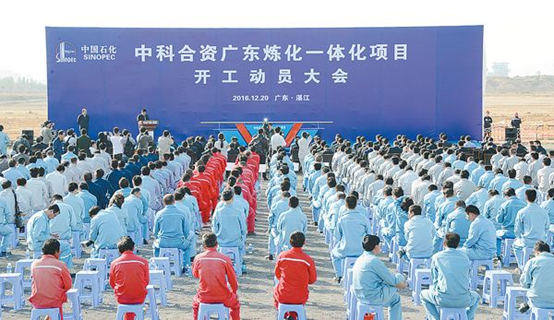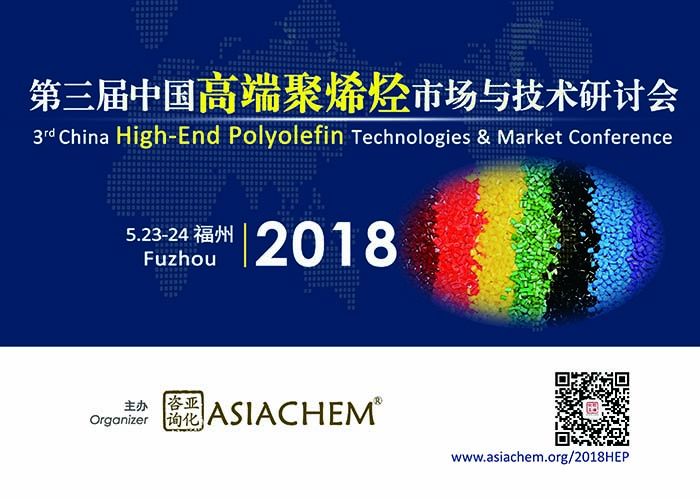• Sino-Kuwait RCI project, with total investment of about CNY 40bn, plans to be put into operation by the end of 2019;
• Using advanced technologies & catalysts, Sino-Kuwait RCI project will produce differentiated, high value-added polyolefin products, such as PE, PP, EVA, etc.
• The 3rd High-End Polyolefin Technologies & Market Conference 2018 will be held on May 23-24 in Fuzhou, and the expert from Sino-Kuwait RCI will be present and introduce “The Advanced Polyolefin Technology Features”.

In “13th Five-Year” period, Sinopec plans to invest CNY 200bn in optimization and upgrading of 4 world-class refining & chemical integration (RCI) bases, namely Maozhan, Zhenhai, Shanghai, and Nanjing, which will have the total oil refining and ethylene capacity of 130Mt/a and 9 Mt/a, respectively. As Sinopec’s biggest project in construction, Sino-Kuwait RCI project has attracted much attention.
Located in Donghai Island Petrochemical Industry Park of Zhanjiang City, Sino-Kuwait RCI project with phase I investment of about CNY 40bn, plans to build 10Mt/a oil refining series production units, as well as 800kt/a ethylene series production units. In Mar 2011, the project passed EIA approval, and was approved by NDRC; in Jul 2016, Sinopec approved the optimization of overall scheme of project, where oil refining section will use the core process of “CDU+ hydrocracking + residue hydrotreating + FCC”, and chemical section will use the product scheme of “HDPE + EO/EG + ethanolamine ethylene derivatives, propylene to PP”.
The oil refining section of Sino-Kuwait RCI project consists of 20 units such as CDU, residue hydrodesulfurization unit, etc.; while chemical section consists of 11 units including steam cracking unit, HDPE unit, PP unit, EVA unit, etc. The project will mainly produce oil products such as CN-VI gasoline, diesel and aviation kerosene, as well as chemical products including PE, PP, EVA, EG, EO, ethanolamine, butadiene, benzene, toluene, mixed xylene, etc.
Based on development plan with “high-end + fine chemical” as the main line, Sino-Kuwait RCI project uses the most advanced production processes and control system in the world, as well as the state-of-the-art energy-saving standard in designing, construction and management, to build a high-end petrochemical industrial base. Polyolefin products of the project aim at differentiation and high-end, for example, the 350kt/a HDPE unit uses the international advanced process and catalyst, to produce high-end HDPE grades including metallocene HDPE; the 100kt/a EVA unit uses advanced process of high valued added LDPE and EVA products, to produce several grades including high-end EVA product with high VA content; the 200kt/a PP unit uses international advanced process and catalyst, to produce many kinds of PP grades.
After the project goes into operation, it will promote the new investment in a series of mid and downstream industries in Zhanjiang City, such as plastic materials, electronic chemicals, fine chemicals, etc., forming superior petrochemical industry chain of high development potential, and the development of its extended product will be benefit for industries such as new material, light industry, automotive, etc.

Sino-Kuwait RCI project has fully started construction on Dec 20th 2016, currently, the base of equipment and device has been fully started and plans to overall finish civil work in the end of Sep 2018, moving to the equipment installation stage; Sinopec issued 2018 investment plan of CNY 100bn, and each engineering of the project is promoted according to timeline, to make sure the project will be put into operation by the end of 2019.

The 3rd High-End Polyolefin Technologies & Market Conference 2018 will be held on May 23-24 in Fuzhou, and the expert from Sino-Kuwait RCI will be present and deliver a presentation, to introduce “The Advanced Polyolefin Technology Features”.